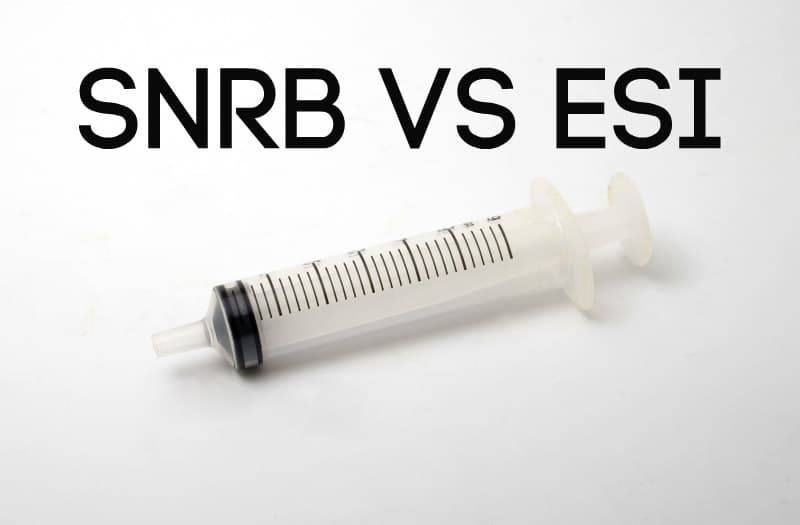Back pain pushes more people into the doctor’s office that any other condition. In the United States, almost 65 million adults reported experiencing back pain recently. While analgesics typically treat most types of back pain, they are not always effective. Many people do not want to take medication every day.
Spinal injections are an option for certain types of back pain. Two options include a selective nerve root block (SNRB) and epidural steroid injection (ESI). Knowing what these injections entail and the differences between them help to ensure that you are informed about these pain-relieving options.
What Are Spinal Injections?
Spinal injections alleviate pain and doctors often use them as a diagnostic tool. Sometimes, if your doctor is unsure of the exact source of your pain, he or she may give an injection into the area responsible. Your doctor bases this on your symptoms and the results of other diagnostic testing.
During the injection procedure, your doctor injects the medicine directly to the painful area. The injections typically calm the nerve pain.If someone has a pinched or irritated nerve, for example, sending medicine directly to the affected nerve may alleviate your pain.
What is the Difference Between SNRB and ESI?
SNRB targets the nerve root where it comes out of the foramen, or the hole located between the vertebral bodies. It includes a mixture of lidocaine which numbs the area and a steroid to alleviate inflammation.
When the doctor suspects a specific nerve of causing pain, they can inject it. If the injection alleviates the pain, this allows them to confirm their diagnosis. And, if the pain remains, this rules out the specific nerve that the doctor injected. Doctors typically inject an SNRB when they suspect a pinched or irritated nerve. This can occur as a result of:
- Narrowed “nerve canal”
- Bulging disc
- Bone spur
Pinched nerves often cause numbness, tingling or pain. By performing an SNRB, this can help to alleviate these symptoms so that you are more comfortable and regain your mobility.
An ESI also delivers numbing and anti-inflammatory medicines via a needle. However, for this, your doctor injects the ESI into a different area. The injection goes into the epidural space, located between the spinal cord and nerve’s protective sac and bone. Fat-filled areas make up this sac.
Your doctor may perform an ESI for pain related to the following:
- Spondylolisthesis
- Degenerative disc
- Spinal stenosis
- Herniated disc
- Sciatica
SNRB and ESI Similarities
Both procedures use fluoroscopy, a type of live imaging that allows the doctor to visualize the internal structures so that they can guide the needle to the proper location.
Each procedure only takes a few minutes to complete. Your unique medical needs determine the time your doctor take performing the procedure, as well as how many injections are being performed at one time.
Once your doctor completes the injections, you can usually go home after a short time in recovery where staff monitor you. Depending on the purpose of the injection, your doctor may recommend doing more than one injection every one to four weeks. If your doctor injects you for diagnostic purposes, you will follow up to discuss your results.
Choosing Between SNRB and ESI
Your doctors diagnosis, or the diagnosis in question determines whether an SNRB or an ESI is best. The doctor may recommend a CT scan, MRI or other imaging to look at the back structures before determining which injection is best.
If your doctor suspects a pinched nerve, an SNRB can be used to either treat it. It can also be used to determine exactly which nerve is causing a person’s symptoms. On the other hand, if your doctor suspects an inflammatory condition, an ESI can be considered.
Sometimes, your doctor may feel as if physical therapy will be more beneficial in alleviating your back pain. These injections may be done before you begin to alleviate pain. Reducing your pain can make physical therapy more tolerable so that you can get the most benefit from the process.
Shots: Diagnostic or Therapeutic
As a diagnostic tool, SNRB and ESI can help your doctor to better determine the source and location of your pain. Doctors typically use SNRB when trying to make a diagnosis. With an SNRB, if you have a bulging disc, narrowing or a bone spur, this can be done to determine which nerves are affected.
After the injection, your doctor looks to see if injecting certain nerves alleviates your pain. This provides important information about the best treatment options for you.
An ESI is more common as a therapeutic treatment. However, your doctor may also use it as a diagnostic method to determine if a specific area is causing your pain. If the injection alleviates your discomfort, this lets the doctor know about the source of your pain. From here, they can recommend targeted treatment options.
As a diagnostic tool, the doctor may only inject a local anesthetic since the goal is to see if injecting a specific area reduces your pain. But as a therapeutic tool, your doctor injects a combination of a numbing medication and a corticosteroid to encourage long-term pain relief.
Steroid Injections
Your doctor may give you a steroid injection to alleviate inflammation. Referred to as corticosteroids, these drugs are closely similar to the hormone cortisol that the body naturally produces. These drugs work by decreasing immune system activity and inflammation.
Inflammation occurs naturally in the body. It occurs to protect the body against foreign organisms and infection via a process that involves chemicals and the white blood cells.
After the threat leaves, this inflammation typically goes away. However, it can also become chronic which can lead to tissue damage. By injecting steroids into inflamed areas, this minimizes tissue damage and the symptoms associated with inflammation, including pain and swelling.
Since SNRBs and ESIs both target specific sites of inflammation, this allows doctor to deliver the anti-inflammatory power of steroids directly to the affected area.
Before receiving steroid shots, or other spinal injections, for nerve pain, make sure that you understand the potential of the procedure. This ensures that you are fully informed about what spinal injections can do and what their limitations are.

